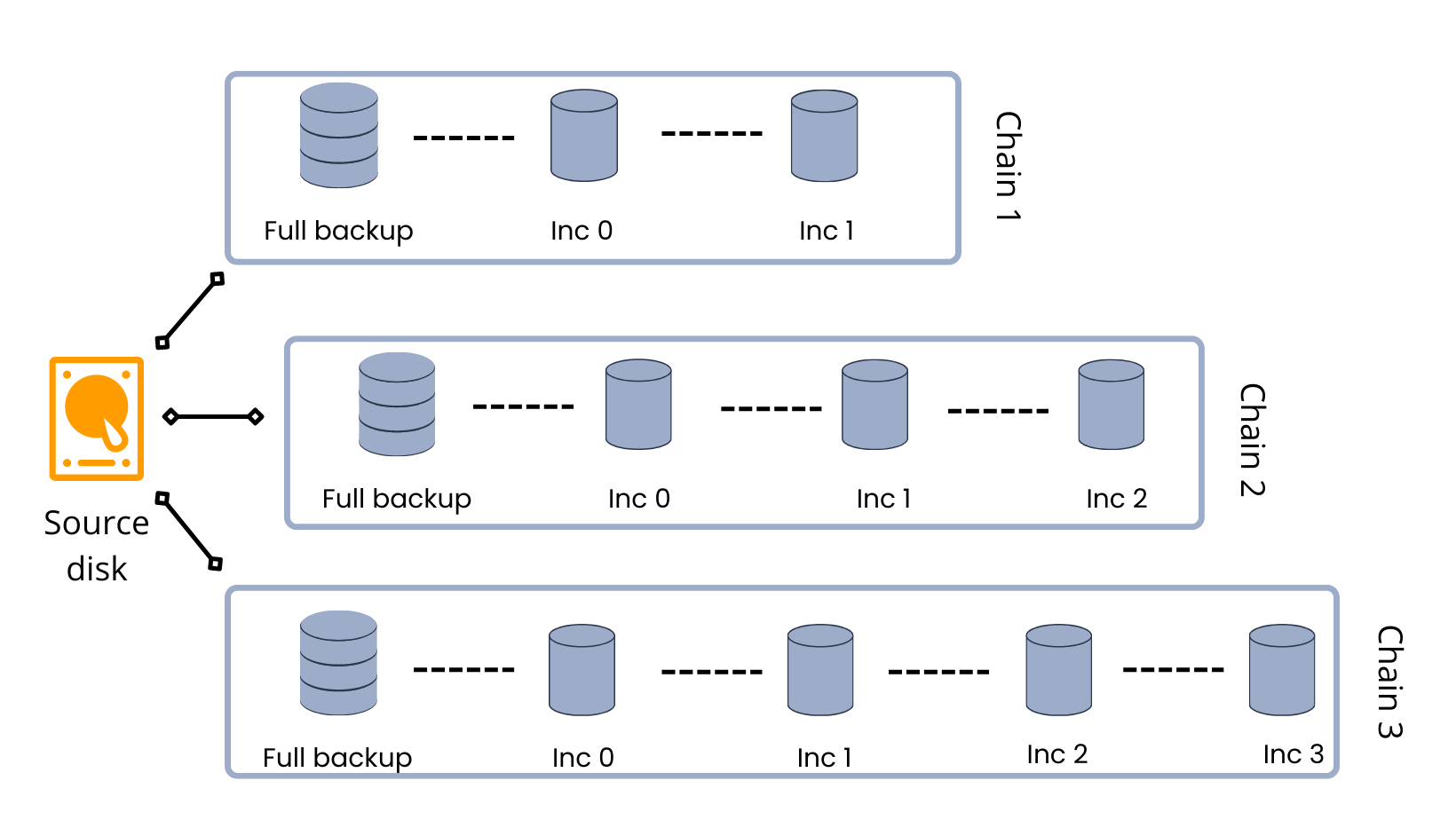Basic Overview
Incremental backup refers to backup the changes of the data on the basis of last backup (maybe full or incremental backup). Since the changes are limited, the incremental backup is much smaller and quicker than a full backup. So, when a full recovery is needed, the restoration process would need the last backup plus all its incremental backups until the point-in-time of the restoration.
When the license expires for backuply and you fail to renew it then restore will not work for backup files taken using backuply option
And for backups, it will switch backup to legacy mode and continue.
Backuply license is needed for Master panel and also for the slave servers for which you want to use backups.
Please enable guest agent in VM for better accuracy
Requirements
Understanding incremental backups in virtualizor
Incremental backups are very small sized backups which consist of changes made since the previous incremental backup. For the incremental backup to take place, a full backup is mandatory. Once a full backup is taken, next backup process will produce small(depends on the changes made since the previous backup) incremental backups which will be linked to the full backup.
A set of incremental backups and its corresponding linked full backup is called as chain. Virtualizor will maintain these chains for each virtual machines in their own separate database. A new chain will be created in case if the VM is shutdowns or restarts or is restored.

Let’s consider the above example where source disk is the VPS disk. If we take an Incremental backup for this disk, then a new chain is created where initially a full backup is created. Now if we take an incremental backup again, it will now create a small backup i.e., inc0. As you further take more incremental backup, more inc backup files will be created.
Inc backups will keep adding to the existing chain unless and until the chain point broken.
If the chain point is broken due to VM shutdown or restart, a new chain will be created.
In Virtualizor, backup folder structure for KVM and Virtuozzo KVM is as follows:
If backup plan directory is “/dir” then the backups will be stored as follows:
Chain 1:
/__dir__/{{VPSUUID}}/__UNIX_TIMESTAMP_1__/full
/__dir__/{{VPSUUID}}/__UNIX_TIMESTAMP_1__/inc0
/__dir__/{{VPSUUID}}/__UNIX_TIMESTAMP_1__/inc1
/__dir__/{{VPSUUID}}/__UNIX_TIMESTAMP_1__/inc2.....
Chain 2:
/__dir__/{{VPSUUID}}/__UNIX_TIMESTAMP_2__/full
/__dir__/{{VPSUUID}}/__UNIX_TIMESTAMP_2__/inc0
/__dir__/{{VPSUUID}}/__UNIX_TIMESTAMP_2__/inc1
/__dir__/{{VPSUUID}}/__UNIX_TIMESTAMP_2__/inc2.....
where,
/__dir__/ is backup path
{{VPSUUID}} Virtual machine’s UUID
UNIX_TIMESTAMP is current unix time stamp.
Here the UNIX_TIMESTAMP represents the chain in which its corresponding full and incremental backups will be stored.

In case of Virtuozzo container, folder structure is different.
Chain 1:
/__dir__/{{VPSUUID}}/__ UNIX_TIMESTAMP __/{{VZUUID}}/CHAINUUID/full
/__dir__/{{VPSUUID}}/__ UNIX_TIMESTAMP __/{{VZUUID}}/{{CHAINUUID}}/inc0
/__dir__/{{VPSUUID}}/__ UNIX_TIMESTAMP __/{{VZUUID}}/{{CHAINUUID}}/inc1
/__dir__/{{VPSUUID}}/__ UNIX_TIMESTAMP __/{{VZUUID}}/{{CHAINUUID}}/inc2.....
Chain 2:
/__dir__/{{VPSUUID}}/__ UNIX_TIMESTAMP __/{{VZUUID}}/{{CHAINUUID}}/full
/__dir__/{{VPSUUID}}/__ UNIX_TIMESTAMP __/{{VZUUID}}/{{CHAINUUID}}/inc0
/__dir__/{{VPSUUID}}/__ UNIX_TIMESTAMP __/{{VZUUID}}/{{CHAINUUID}}/inc1
/__dir__/{{VPSUUID}}/__ UNIX_TIMESTAMP __/{{VZUUID}}/{{CHAINUUID}}/inc2.....
where,
/__dir__/ is backup path
{{VPSUUID}} Virtual machine’s UUID
UNIX_TIMESTAMP is current unix time stamp.
{{VZUUID}} is Virtual Machine’s UUID
{{CHAINUUID}} is chain the chain ID created by Virtuozzo during backup
Let’s consider the above example where source disk is the VPS disk. If we take an Incremental backup for this disk, then a new chain is created where initially a full backup is created. Now if we take an incremental backup again, it will now create a small backup i.e., inc0. As you further take more incremental backup, more inc backup files will be created.
Inc backups will keep adding to the existing chain unless and until the chain point broken.
If the chain point is broken due to VM shutdown or restart, a new chain will be created.
In Virtualizor, backup folder structure for KVM and Virtuozzo KVM is as follows:
If backup plan directory is “/dir” then the backups will be stored as follows:
Chain 1:
/__dir__/{{VPSUUID}}/__UNIX_TIMESTAMP_1__/full
/__dir__/{{VPSUUID}}/__UNIX_TIMESTAMP_1__/inc0
/__dir__/{{VPSUUID}}/__UNIX_TIMESTAMP_1__/inc1
/__dir__/{{VPSUUID}}/__UNIX_TIMESTAMP_1__/inc2.....
Chain 2:
/__dir__/{{VPSUUID}}/__UNIX_TIMESTAMP_2__/full
/__dir__/{{VPSUUID}}/__UNIX_TIMESTAMP_2__/inc0
/__dir__/{{VPSUUID}}/__UNIX_TIMESTAMP_2__/inc1
/__dir__/{{VPSUUID}}/__UNIX_TIMESTAMP_2__/inc2.....
where,
/__dir__/ is backup path
{{VPSUUID}} Virtual machine’s UUID
UNIX_TIMESTAMP is current unix time stamp.
Here the UNIX_TIMESTAMP represents the chain in which its corresponding full and incremental backups will be stored.

